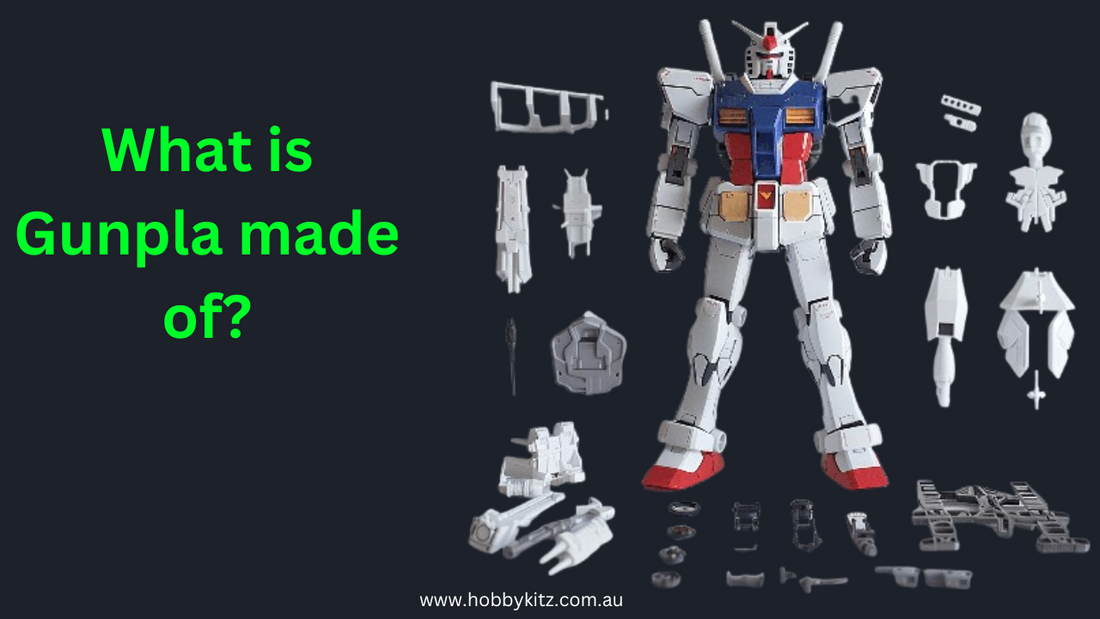
What is Gunpla made of? And is it recyclable?
Share
Gunpla, short for "Gundam plastic models," has become a staple in the world of model building and hobbyism. These intricate, snap-fit models allow fans of the Mobile Suit Gundam franchise to recreate their favorite mobile suits and bring them to life in their own homes. But what exactly is Gunpla made of, and can it be recycled? In this article, we’ll explore the materials used in Gunpla production and discuss whether these iconic model kits are recyclable.

What is Gunpla Made Of?
Gunpla model kits are made primarily from plastic, specifically polystyrene plastic. Polystyrene is a versatile and durable material commonly used in model kits, toys, and other consumer products. Here’s a closer look at the materials and components that make up Gunpla kits:
1. Polystyrene Plastic
Polystyrene is the most common material used for Gunpla. It is lightweight, easy to mold, and relatively inexpensive, making it ideal for producing detailed, intricate model kits. Polystyrene is used for the runners (the frames that hold the individual model parts before they are clipped out), as well as for the actual model pieces themselves.
-
Advantages of Polystyrene:
- Easy to work with.
- High level of detail in molding.
- Strong enough to hold its shape but light enough to avoid making models too heavy.
- Can be painted and modified easily by model builders.
2. ABS Plastic
In addition to polystyrene, ABS (Acrylonitrile Butadiene Styrene) plastic is also used in some Gunpla kits. ABS is stronger and more durable than regular polystyrene, which makes it suitable for parts that need to withstand stress or movement, such as joints, frames, and internal mechanisms. ABS plastic is also used in some higher-end Gunpla kits for added detail and functionality.
-
Advantages of ABS Plastic:
- Stronger and more durable than polystyrene.
- Can handle movement and stress better, ideal for articulation.
- Offers a slightly more premium feel in high-grade kits.
3. PVC (Polyvinyl Chloride) Parts
Some Gunpla kits include PVC parts, particularly for accessories such as weapons, or smaller details like straps and hoses. PVC is flexible and soft, making it suitable for parts that need a bit of bend or movement without breaking.
-
Advantages of PVC:
- Flexible and bendable.
- Resistant to breaking under pressure, making it perfect for small, delicate components.
4. Stickers, Decals, and Markers
In addition to the plastic components, Gunpla kits often come with a variety of stickers, decals, and markers for customization. These are typically made from vinyl or paper and are used to add extra details to the model, such as logos, panel lines, and other decorative elements. Stickers and decals allow builders to enhance the look of their models without needing to paint them.
-
Advantages of Stickers and Decals:
- Adds customization without requiring painting.
- Allows for easier assembly for beginners.
Is Gunpla Recyclable?
Given that Gunpla models are primarily made from plastics such as polystyrene, ABS, and PVC, the question of whether they are recyclable is an important consideration for environmentally conscious builders. Let’s explore the recyclability of Gunpla materials.

1. Polystyrene Plastic (PS)
Polystyrene is technically recyclable, but it is not commonly recycled in most municipal recycling programs. Due to its lightweight nature, polystyrene is often not economically viable to recycle on a large scale. Additionally, polystyrene is prone to breaking into small pieces, making it harder to process in recycling plants. However, if you live in an area with specialized plastic recycling facilities, it may be possible to recycle your Gunpla parts that are made from polystyrene.
-
Recycling Consideration:
- Yes, polystyrene can be recycled, but it is not widely accepted in many areas.
- Some regions have specific recycling programs for this material.
2. ABS Plastic
ABS plastic is more commonly recycled than polystyrene, and it’s used in various industries due to its durability. ABS recycling is more prevalent because the material is stronger and has a higher demand for reuse in manufacturing. That said, ABS plastics used in Gunpla kits are often small and specific to a single model, which may limit their recyclability in a conventional recycling program.
-
Recycling Consideration:
- Yes, ABS plastic is recyclable.
- However, the small parts and low quantities from Gunpla kits may make it impractical for general recycling programs.
3. PVC (Polyvinyl Chloride)
PVC is one of the more challenging plastics to recycle, especially when it comes to the flexible, soft components used in Gunpla kits. The material requires specialized processes to break down, and as a result, it is often not accepted in standard recycling systems. Some types of PVC are more recyclable than others, but generally, this plastic is not considered environmentally friendly when disposed of improperly.
-
Recycling Consideration:
- No, PVC is generally not recyclable in standard systems.
- It requires specialized recycling facilities to handle PVC waste, which are not common in most areas.
4. Stickers, Decals, and Markers
The stickers, decals, and markers that come with Gunpla kits are usually made from vinyl, paper, or other materials that are not easily recyclable. Stickers and decals are particularly difficult to recycle due to their small size and the adhesives used, which can complicate the process. Markers may contain inks that are not environmentally friendly either.
-
Recycling Consideration:
- No, stickers, decals, and markers are not recyclable through standard channels.
- Some eco-friendly alternatives to traditional markers and stickers are available, but they are not commonly included in standard Gunpla kits.
Can You Recycle Gunpla Model Kits?
The short answer is it depends. The primary materials used in Gunpla kits—polystyrene, ABS, and PVC—can technically be recycled, but they are not widely accepted in most recycling programs. If you're serious about recycling your Gunpla models, here are a few steps you can take:
1. Separate Materials
To increase the chances of recycling, try to separate the different materials (polystyrene, ABS, PVC) before disposal. This makes it easier for specialized facilities to process them if they accept these types of plastics.
2. Look for Specialized Facilities
Check if your area has a recycling center that accepts the types of plastics used in Gunpla. Some areas offer special recycling programs for plastic model kits and similar items.
3. Reuse and Repurpose
Instead of discarding your Gunpla parts, consider repurposing them for other crafting projects, creating custom Gunpla accessories, or even recycling them as art materials. This approach reduces waste and gives your models a second life.
4. Donate or Sell Unused Kits
If you no longer want to keep your Gunpla kits, consider donating or selling them to other modelers or hobbyists. This keeps the models in circulation and helps someone else enjoy the hobby without contributing additional plastic waste.
Conclusion
Gunpla models are primarily made from polystyrene, ABS, and PVC, which are plastics with varying degrees of recyclability. While polystyrene and ABS are recyclable in some areas, PVC is more difficult to recycle. Unfortunately, many of the parts and accessories included in Gunpla kits—such as decals and markers—are not easily recyclable.
For environmentally conscious model builders, it’s important to look for recycling options in your area or repurpose Gunpla parts creatively to reduce waste. As the Gunpla community grows, there is also potential for the industry to shift toward more sustainable materials in the future.
